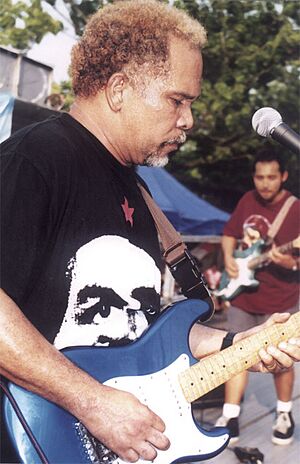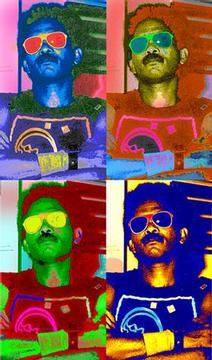Luis Días (composer) facts for kids
Quick facts for kids
Luis Días
|
|
|---|---|

Luis Días
|
|
| Background information | |
| Birth name | Luis Días Portorreal |
| Born | June 21, 1952 Bonao, Dominican Republic |
| Died | December 8, 2009 (aged 57) Santo Domingo, Dominican Republic |
| Genres | Popular Dominican Music |
| Occupation(s) | Musician, singer-songwriter, composer, guitarist |
| Instruments | Guitar |
| Years active | 1972–2009 |
Luis Días Portorreal, known to many as Luis Días, was a talented musician, composer, and singer from the Dominican Republic. He was deeply connected to the popular music and traditions of his country. People often called him "El Terror" ("The Terror") because of his unique way of performing and his strong musical style.
Luis Días wrote songs and music that mixed many different styles. Some people even called him the Father of Dominican Rock. This is because he helped create new kinds of music by blending Dominican rhythms with rock guitar sounds. He mixed rock, reggae, jazz, and blues with over 40 traditional rhythms from the Dominican Republic and Haiti. These included Merengue, Bachata, and Mangulina.
Contents
About Luis Días
Luis Días Portorreal was born in Bonao, Dominican Republic, on June 21, 1952. From a young age, he loved music. His father played the Tres, which is an instrument like a guitar used in the countryside. His mother sang Salves, which are traditional religious songs. So, music and art were always a natural part of his life.
He started learning music in his hometown with musicians Juan Zorrilla and Tatán Jiménez. When he was 16, he formed his first band called "Los Chonnys." In 1970, he moved to Santo Domingo to study psychology at the Universidad Autónoma de Santo Domingo. Luis Días passed away in Santo Domingo on December 8, 2009, after having a heart attack. His funeral was one of the longest in recent Dominican history, with many people joining the procession through the streets of Santo Domingo.
His Musical Journey
In 1972, Luis Días joined a band called Convite as a guitarist and singer. This band aimed to bring back and celebrate many traditional rhythms from the island. Convite was quite new and exciting for its time. They performed at a big event called "El Festival Internacional de la Nueva Canción "Siete Días con el Pueblo"" (International Festival of the New Song "Seven Days with the People") in Santo Domingo in 1974. Luis's song "Obrero Acepta Mi Mano" (Laborer, Accept My Hand) became the official theme song for the festival.
After Convite broke up in 1978, Luis formed another band called "Madora." With this new group, he tried to mix jazz with Caribbean folk music. In "Madora," Luis spent a decade working on and bringing back old Dominican traditional songs. He also took part in the XI World Festival of Youth and Students in La Habana, Cuba, in 1978.
Between 1980 and 1982, Luis Días went to New York City. There, he taught workshops about traditional Dominican music at the American Museum of Natural History. During this time, he was greatly inspired by jazz and punk culture.
The Start of Dominican Rock
Even though different kinds of rock music were played in the Dominican Republic before, many people believe that Luis Días's return in 1982 marked the true beginning of Dominican Rock. He formed a band called Transporte Urbano (Urban Transportation). The band included Juan Francisco Ordóñez on guitar, Guy Frómeta on drums, Héctor Santana on bass guitar, José Duluc on percussion, and Bruno Ranson on saxophone. A few years later, Peter Nova took over on bass guitar. In Transporte Urbano, they blended many musical styles, from Bachata to heavy metal.
Awards and Achievements
In 1983, Luis Días won a national award for writing the main song for the Dominican Carnival. The song was called "Carnaval," but it's better known as "Baila en la Calle" (Dance in the Streets). Sonia Silvestre and Luis Días first performed it. By 1985, the famous Dominican merenguero Fernando Villalona recorded the song, and it became very popular.
In 1984, his album Luis "Terror" Días was released. It mostly had songs with Merengue rhythms, like "Ay Ombe" and "Baila en la Calle." He also participated in the XII World Festival of Youth and Students in Moscow in 1985.
Luis Días and Juan Luis Guerra worked together to create the main song for a short film called Las Pausas del Silencio. They won a silver award for Best Original Music at the Philadelphia International Film Festival in 1984.
In 1986, he published a poetry book called Tránsito Entre Guácaras (Transportation in Between Caves). This book was inspired by Taíno myths. UNICEF also hired him to write a song called "Los Niños Sin Padres" ("Children Without Parents"), which he performed with singers Sergio Vargas and Sonia Silvestre.
More than 300 of his songs have been recorded by many different artists and bands. Some well-known examples include: Sergio Vargas ("Marola"), Wilfrido Vargas ("La Pringamosa"), Sonia Silvestre ("Mi Guachimán"), Fernando Villalona ("Carnaval (Baila en la Calle)"), and Marc Anthony ("Si He De Morir").
He received many awards, including Lyricist of the Year (Casandra Awards, 1989) and Composer of the Year (Casandra Awards, 1990).
After performing in the Caribbean, the United States, South America, Paris, Moscow, Madrid, and other cities, he returned to New York in 1991. There, he continued his important work in culture and ethnic studies.
During this time, Luis Días composed music for several films. One example is the short film "Portrait of Teresa" (1993). He also worked with David Byrne on the music for the film Blue in the Face (1995). In this film, Marc Anthony sang Luis's song "Mi Barrio."
In 1997, he returned to Santo Domingo. His concerts were very popular, and he released his first CD recordings. In 1999, a cultural center in Santo Domingo chose his work for a collection called Jaleo Dominicano + Homenaje a Luis Días. This was the first time they honored an artist from the American continent in this way. That same year, he became the Director of the Music Department at the Casa de la Cultura Dominicana in New York.
Between 2002 and 2003, he started recording for Radio Macana, an album that included his band "Las Maravillas." This project showed his work from his time in New York between 1999 and 2002.
In 2004, the Dominican Government named him "National Cultural Patrimony." This means he was recognized as a very important part of the country's culture. A concert was held in Santo Domingo to celebrate this honor, and it was recorded and released as a DVD called "Luis Terror Días: El Terror en Vivo."
In 2005, he put together a Merengue band to perform some of his famous songs that other artists had made popular. This performance was also recorded and released as a DVD. That same year, he wrote the music for the Dominican film La Maldición del Padre Cardona (The Curse of Father Cardona).
In 2006, there was a discussion involving the singer Shakira and Wyclef Jean. Their song "Hips Don't Lie" used a part of Luis Días's "Carnaval (Baila en la Calle)" without giving him credit.
Luis Días passed away in Santo Domingo on December 8, 2009, at 57 years old.
Discography
Albums
- Luis “Terror” Dias (1984)
- Merenrock (1988)
- El Accidente (1998)
- Vickiana: Las Sesiones De 1985 (2000)
- La Yola (2000)
- Radio Macana (2003)
- Tiempo De Ocio (2009)
Singles & EPs
- Baila En La Calle (1983)
- El Transporte Urbano (1983)
- Luis Dias Trio (1999)
Compilations
- Jaleo Dominicano + Homenaje A Luis Dias (1999)
- La Suite Folklorica Dominicana (2001)
- Lo Mejor Del Terror (2009)


